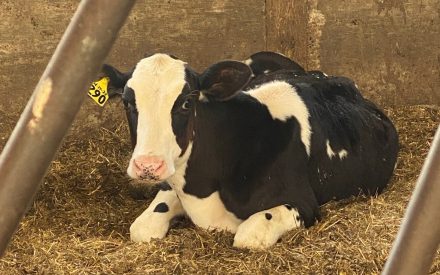English | Español
Introduction
Raising heifers is one of the most cost-intensive areas of the farm. From the day these animals hit the ground until they calve, they are a monetary burden on the farm. Therefore, getting these animals to calving as efficiently as possible makes sense.

Traditionally heifers have been bred by age, with the rule of thumb being that they should calve in between 22 and 24 months. Research has shown us that every month past 22 months of age, these animals cost the farm $100/ animal1. If your farm consistently calves at 24 months of age, this is an additional $200/ animal you are spending on a non-money earning asset.
How do we get them bred and calving by 22 months of age? If we strictly breed based on age, we will have some animals that are too small and some that are too big. Undersized heifers are prone to more problems at calving and produce less milk during their lifetime. Therefore, the focus of your heifer breeding program should be primarily on the size of the animal at breeding. For this strategy to work, it is essential to monitor heifer growth.
Measuring heifers
Many farmers can accurately identify the body condition score of an over-or underweight animal. However, it is difficult to determine whether an animal is average for its age. Van Dijk et al. showed that veterinarians underestimate the weight of dairy cows 65% of the time and are off on average by 140 pounds2. The same study showed that dairy farmers were off 81% of the time, and their estimates were off an average of 214 pounds. Accurate body weight measurements can be obtained using a scale or weight tape. A correctly calibrated scale will give the most accurate weight of the animal and is a good investment that can be used throughout the farm. Weight tapes allow for an estimation of an animal’s weight by measuring the heart girth and are accurate to within 3 to 5% of the actual body weight for animals over 330 pounds4. The weight tape is slightly less accurate for calves weighing 110 to 330 pounds (within 5 to 8% of actual body weight) 3. Due to the difficulty in measuring the heart girth of heifers, proper animal restraint and good footing should be a priority for both worker and animal safety.
To collect accurate weights the scale must be placed on a level surface and zeroed between each animal. The scale should be calibrated regularly depending on its frequency of use. Cleaning the scale after use will help prolong its useful life.
When using weight tape, the animal must be on a level surface with her head upright. The tape is placed snugly around the heart girth just behind the front legs and shoulder blades. There should not be excess mud or manure present when measuring as this can create an error. It is essential to make sure you use a weight tape constructed using measurements from modern dairy animals and your cattle breed. Some weight tapes on the market were made using measurements from animals in the late 1800s. These weight tapes will not accurately measure the weight of 21st-century animals. Weight tapes can be purchased for calf and cow weights relatively cheaply from many farm suppliers.
The stature of the heifer is also essential when determining if she is ready to breed. Stature can be determined by either measuring hip height or height at the withers. When measuring stature, the animal must be on a level surface. If you measure at the withers, the animal’s head needs to be upright, and you need to measure at the highest point of the withers. When measuring hip height, the position of the head is not essential. Measurements should be taken using a frame score measuring stick. The stick should be held parallel to the animal.
Breeding heifers
It is recommended that heifers reach 55% of mature body weight and 90% of mature structural growth3 by the time you breed them. Therefore, it is necessary to look at both the weight and the height of the animal before deciding if she is ready to be bred. Breeding too early is also detrimental to your bottom line. It used to be recommended to use breed averages when comparing heifer growth rates. However, monitoring heifer growth compared to measurements of mature animals in the herd accounts for herd-specific genetics and management. PennState Extension has developed a customized growth chart spreadsheet ↗️ to help producers keep track of heifer growth. After calving, heifers should be at 85 to 90% mature body weight and should have achieved 95% of mature structural growth.
Conclusion
Knowing your herd’s average weight and height will allow you to accurately set a target weight and height for your growing heifers. Regularly monitoring the growth of these animals will allow you to alter heifer rations to obtain breeding weight and height in an optimal time frame. Optimizing your time from birth to breeding will ultimately help your bottom line.
References
Lormone, Mike. The case for a quality dairy replacement program. 2005. In proceedings from Dairy Calves and Heifers: Integrating Biology and Management Conference.
van Dijk, J., S.J. Eagle, A.V. Gillespie, R.F. Smith, A.N. Holman, and H.J. Williams. 2015. Visual weight estimation and the risk of underdosing dairy cattle. Vet.Record. 177:75 – 78
PennState Extension. April 25, 2016. Monitoring Dairy Heifer Growth. https://extension.psu.edu/monitoring-dairy-heifer-growth. Accessed Dec, 30th 2021.
Author

Heather Schlesser
County Dairy Educator – Heather Schlesser is an Agriculture Educator in Marathon County. Heather’s research and outreach have included the use of current technology to enhance farm profitability and sustainability. Her current projects include the Animal Wellbeing Conference, the Midwest Manure Summit, Beef Quality Assurance, financial programming, and teaching farmers throughout the Midwest how to breed their own cattle.
Download Article


 Getting the Dairy Herd You Want Through Improved Genetic Selection
Getting the Dairy Herd You Want Through Improved Genetic Selection Renovating Tie-Stall Barns for Indoor Calf Housing
Renovating Tie-Stall Barns for Indoor Calf Housing Calf Recumbency aka Early Onset Muscle Weakness Syndrome
Calf Recumbency aka Early Onset Muscle Weakness Syndrome Cómo obtener el hato que desea a través de una mejor selección genética
Cómo obtener el hato que desea a través de una mejor selección genética


